“Global AI In Medical Imaging Market to reach a market value of USD 10.3 Billion by 2030 growing at a CAGR of 32.2%”
The Global AI In Medical Imaging Market size is expected to reach $10.3 billion by 2030, rising at a market growth of 32.2% CAGR during the forecast period.
Neuroimaging greatly aids the early detection and diagnosis of neurological disorders, including stroke, brain tumors, neurodegenerative diseases (such as Alzheimer’s and Parkinson’s), and multiple sclerosis. Therefore, the neurology segment captured $423.3 million revenue in the market in 2022. To enhance the quality of life and patient outcomes, AI algorithms may evaluate neuroimaging data to detect early indicators of pathology, describe the course of a disease, and forecast patient outcomes.
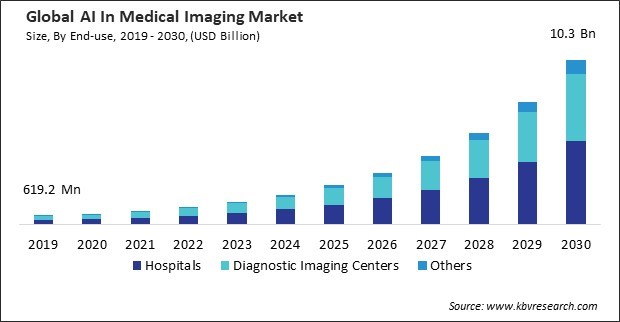
The major strategies followed by the market participants are Partnerships, Collaborations & Agreements as the key developmental strategy to keep pace with the changing demands of end users. For instance, In March, 2024, Siemens Healthineers AG joined hands with SmartAlpha. Under this partnership, the companies delivered cutting-edge AI-driven solutions designed to enhance workflow efficiencies and ensure consistent optimization of clinical performance. Additionally, In December, 2023, Agfa-Gevaert NV came into a partnership with Corista. Under this partnership, the DP3 technology of Corista was integrated with Enterprise Imaging for Pathology platform of Agfa-Gevaert.
Based on the Analysis presented in the KBV Cardinal matrix; Microsoft Corporation and Google LLC (Alphabet Inc.) are the forerunners in the market. In March, 2024, Microsoft Corporation expanded the partnership with NVIDIA Corporation, an American multinational corporation and technology company. Under this extended partnership, Microsoft Azure was integrated with NVIDIA DGX Cloud and the NVIDIA Clara suite of computing platforms, software, and services. Additionally, this extended partnership empowered healthcare and life sciences organizations to expedite innovation and enhance patient care by leveraging advanced AI capabilities and scalable cloud infrastructure. Companies such as General Electric Company, IBM Corporation, NVIDIA Corporation are some of the key innovators in the market.
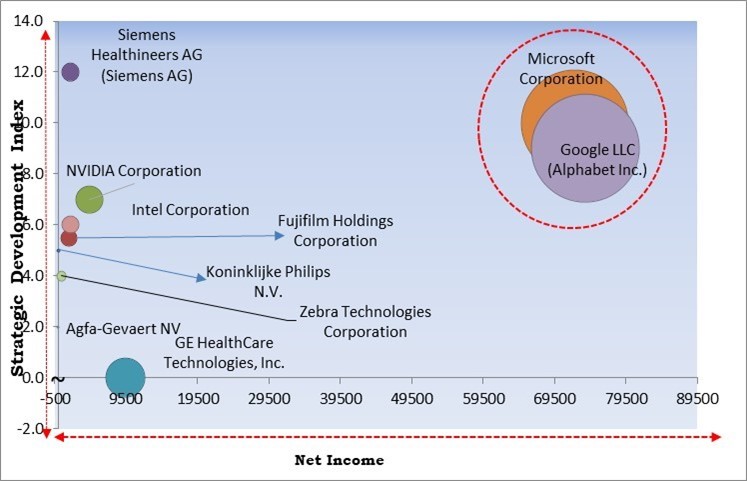
The demand for AI-powered imaging systems that facilitate the remote interpretation of medical images surged due to the pandemic’s acceleration of telehealth and remote diagnostics deployment. AI algorithms facilitate the rapid analysis and triage of imaging studies, allowing healthcare providers to remotely assess and monitor patients, particularly those with COVID-19-related complications or other urgent medical conditions. Thus, the COVID-19 pandemic positively impacted market.
Precision medicine relies heavily on accurate and detailed medical imaging to identify specific biomarkers and genetic variations. AI-powered medical imaging systems can analyze these pictures at a speed and accuracy never before possible, enabling medical professionals to diagnose patients more precisely and create individualized treatment regimens for each patient. Therefore, the rising demand for precision medicine drives the market’s growth.
Personalized medicine requires tailored imaging protocols to effectively capture specific disease characteristics and individual patient variations. AI algorithms can adapt imaging protocols based on patient demographics, clinical history, and genetic information, optimizing image acquisition parameters for better diagnostic accuracy and treatment planning. Hence, increasing personalized medicine and treatment planning propels the market’s growth.
Medical imaging involves generating and analyzing sensitive patient data, including imaging scans, medical histories, and clinical notes. As such, there are stringent regulations, such as HIPAA (Health Insurance Portability and Accountability Act) in the United States, that mandate the protection of patient confidentiality. Thus, data privacy and security concerns are hampering the market’s growth.
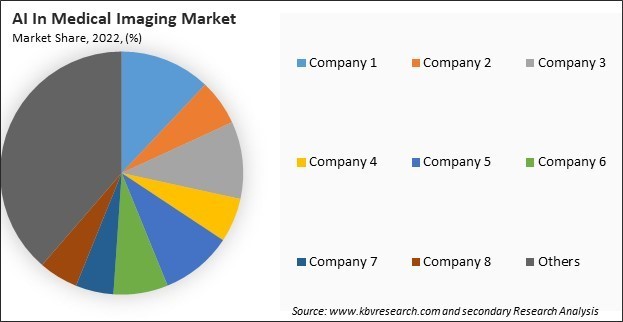
The leading players in the market are competing with diverse innovative offerings to remain competitive in the market. The above illustration shows the percentage of revenue shared by some of the leading companies in the market. The leading players of the market are adopting various strategies in order to cater demand coming from the different industries. The key developmental strategies in the market are Partnerships, Collaborations & Agreements.
Based on technology, the market is divided into deep learning, natural language processing (NLP), and others. The natural language processing (NLP) segment attained 32.9% revenue share in the market in 2022. NLP algorithms can automate the generation of structured radiology reports from unstructured text, reducing the time and effort required by radiologists to create reports manually.
Based on modality, the market is categorized into CT scan, MRI, X-rays, ultrasound, and nuclear imaging. The X-rays segment held 13.2% growth rate in the market in 2022. X-rays are often used for routine screening and initial diagnosis of common conditions, such as fractures, pneumonia, and dental problems.

By end-use, the market is divided into hospitals, diagnostic imaging centers, and others. The diagnostic imaging centers segment procured 40.5% revenue share in the market in 2022. Diagnostic imaging centers face pressure to optimize operational efficiency and streamline radiology workflows to accommodate increasing patient volumes and reduce waiting times.
On the basis of application, the market is segmented into neurology, respiratory & pulmonary, cardiology, breast screening, orthopedics, and others. The cardiology segment held 15.8% growth rate in the market in 2022. Globally, the primary causes of morbidity and mortality are cardiovascular diseases (CVDs), which include heart failure, arrhythmias, and coronary artery disease.
Free Valuable Insights: Global AI In Medical Imaging Market size to reach USD 10.3 Billion by 2030
Region-wise, the market is analysed across North America, Europe, Asia Pacific, and LAMEA. The North America region witnessed 41.5% revenue share in the market in 2022. North America boasts one of the most advanced healthcare infrastructures globally, with state-of-the-art hospitals, research institutions, and medical facilities equipped with advanced imaging modalities such as MRI, CT, PET, and ultrasound.
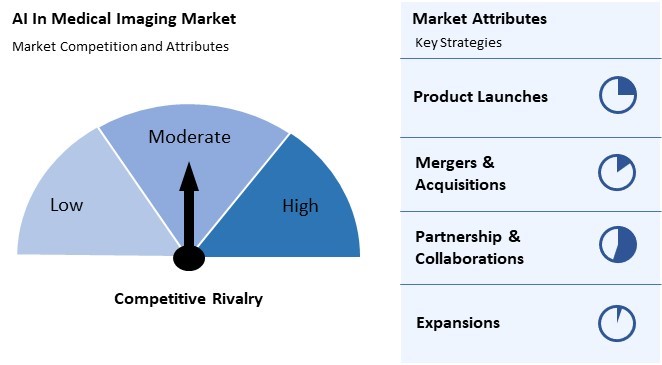
The market competition in the AI in Medical Imaging sector is robust and dynamic, characterized by a diverse array of players ranging from established industry leaders to innovative startups. As the demand for AI-driven solutions in medical imaging continues to grow, competition among companies intensifies, driven by factors such as technological innovation, regulatory compliance, and strategic partnerships. Established players leverage their brand reputation, extensive resources, and established customer bases to maintain market dominance and drive adoption of their AI solutions. These companies invest heavily in research and development to enhance their product offerings, expand their market reach, and stay ahead of emerging competitors.
| Report Attribute | Details |
|---|---|
| Market size value in 2022 | USD 1.1 Billion |
| Market size forecast in 2030 | USD 10.3 Billion |
| Base Year | 2022 |
| Historical Period | 2019 to 2021 |
| Forecast Period | 2023 to 2030 |
| Revenue Growth Rate | CAGR of 32.2% from 2023 to 2030 |
| Number of Pages | 325 |
| Number of Tables | 494 |
| Report coverage | Market Trends, Revenue Estimation and Forecast, Segmentation Analysis, Regional and Country Breakdown, Market Share Analysis, Competitive Landscape, Porter’s 5 Forces Analysis, Company Profiling, Companies Strategic Developments, SWOT Analysis, Winning Imperatives |
| Segments covered | Technology, Modality, Application, End-use, Region |
| Country scope |
|
| Companies Included | Siemens Healthineers AG (Siemens AG), GE HealthCare Technologies, Inc., Koninklijke Philips N.V., Fujifilm Holdings Corporation, Agfa-Gevaert NV, Microsoft Corporation, Google LLC (Alphabet Inc.), Intel Corporation, NVIDIA Corporation, Zebra Technologies Corporation |
By Technology
By Modality
By End-use
By Application
By Geography
The Market size is projected to reach USD $10.3 billion by 2030.
Rising demand for precision medicine are driving the Market in coming years, however, Data privacy and security concerns restraints the growth of the Market.
Siemens Healthineers AG (Siemens AG), GE HealthCare Technologies, Inc., Koninklijke Philips N.V., Fujifilm Holdings Corporation, Agfa-Gevaert NV, Microsoft Corporation, Google LLC (Alphabet Inc.), Intel Corporation, NVIDIA Corporation, Zebra Technologies Corporation
The Deep Learning segment is registering maximum revenue in the Market by Technology in 2022; thereby, achieving a market value of $5.8 billion by 2030.
The North America region dominated the Market by Region in 2022, and would continue to be a dominant market till 2030; thereby, achieving a market value of $4.1 billion by 2030.
Our team of dedicated experts can provide you with attractive expansion opportunities for your business.
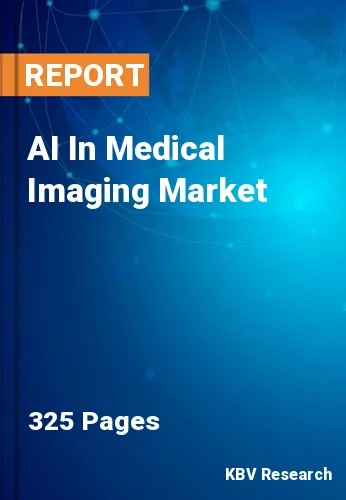
 Drivers
Drivers
 Restraints
Restraints
 Opportunities
Opportunities
 Challenges
Challenges
